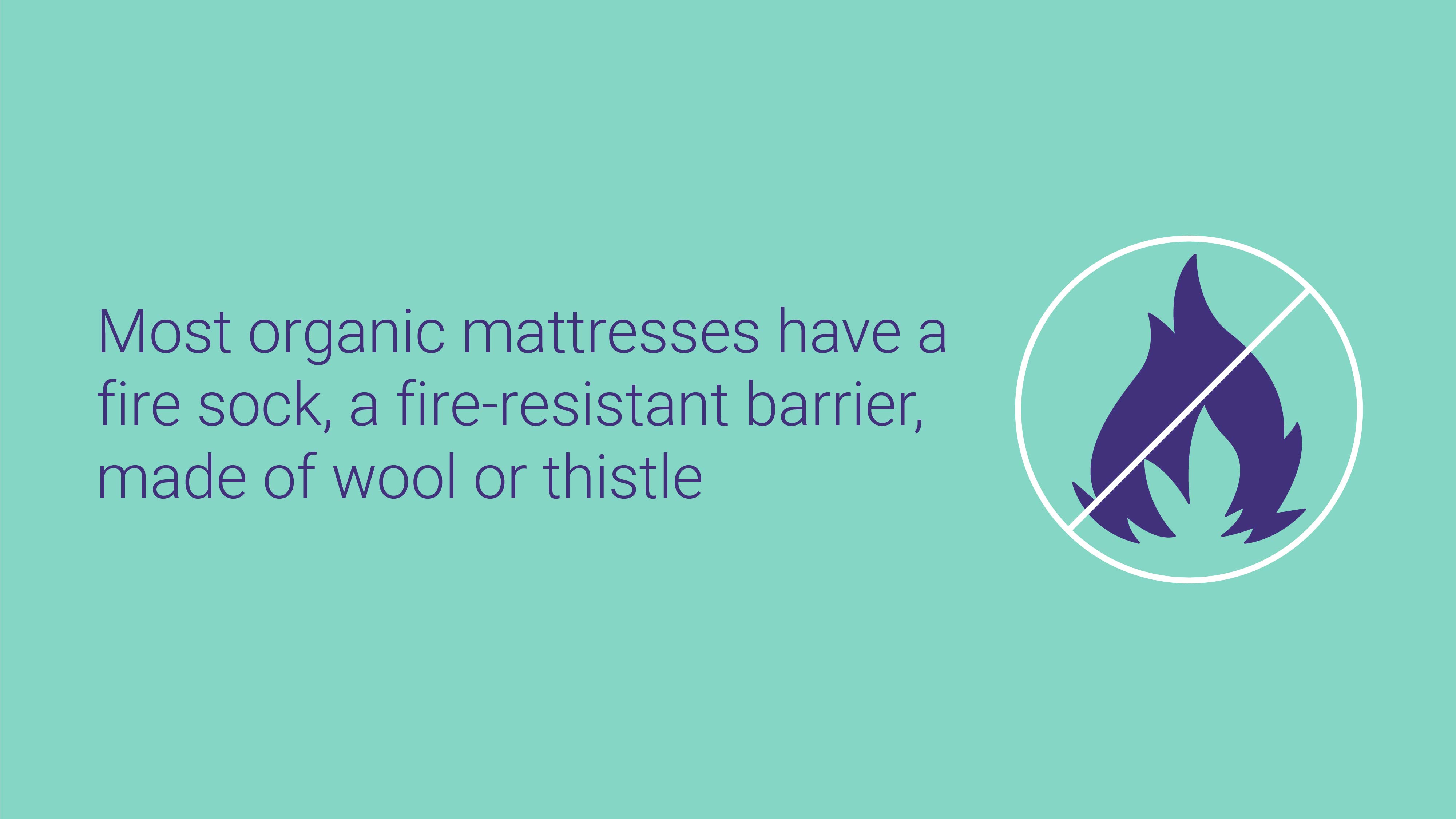What is an Organic Mattress?

- With increased consumer awareness of harmful chemicals in household products, terms like “organic,” “green,” “eco-friendly,” and “all-natural” have become crucial. However, the lack of official standards in the mattress industry makes it challenging to identify truly organic mattresses.
- Organic mattresses are defined as those made with materials harvested and manufactured using organic methods. Key components include natural latex, certified organic fibers like cotton and wool, fire-resistant barriersthat aren’t chemical flame retardants, and foams that may include plant-based memory foam.
- Several independent certifications help identify organic mattresses, such as Global Organic Textile Standard (GOTS), Global Organic Latex Standard (GOLS), United States Department of Agriculture (USDA) Organic/Natural Organic Program (NOP), MADE SAFE, CertiPUR-US®, and eco-INSTITUT.
A growing awareness of the harmful chemicals that can enter the home with everyday household products has made consumers more aware of how their mattresses are made. Terms like organic, green, eco-friendly, and all-natural have become buzz words for identifying products low in emissions and toxic substances.
However, in the mattress industry where there are no official standards or regulations that define those terms, it can be difficult to identify a truly organic mattress. Armed with the knowledge of the materials and certifications to look for, you can find a mattress with comfortable organic layers on the inside and covered in breathable organic fabrics and textiles on the outside. And, the peace of mind it offers could help you sleep better.
What Makes a Mattress Organic?
For the purposes of this article, we’ll define an organic mattress as one that’s made with materials harvested and manufactured using organic methods. Organic doesn’t necessarily mean eco-friendly, but many organic mattresses leave a smaller carbon footprint because of their organic beginnings.
Confusion enters the picture when mattress retailers or manufacturers advertise eco-friendly, natural or organic mattresses, but they don’t define what they mean by that term. For some mattresses, that label may only apply to a small portion of the mattress like the mattress cover or a single layer within the interior. For others, it may apply to the harvesting or growing of materials but not to how they were manufactured or vice versa. But, you can start to identify an organic mattress by knowing the kinds of materials to look for.
Natural latex
Latex foam can either be made of natural, blended, or synthetic latex. Natural latex originates from the sap of the rubber tree. It goes through one of two manufacturing processes to become either Dunlop or Talalay latex.
Latex mattresses made entirely of Dunlop and/or Talalay layers can be certified organic. However, a mattress can be made of natural latex and not be certified organic due to the methods used in the growing, harvesting, and manufacturing of the latex.
Synthetic latex is never organic. It’s completely man-made and derived from petrochemicals. Blended latex combines natural and synthetic latex. While blended latex may have fewer emissions or cause less exposure to chemicals than synthetic latex, it won’t be certified organic due to the synthetic latex content. The ratio of blended to natural latex varies by manufacturer and mattress model. Generally speaking, the higher the natural latex content, the more expensive the mattress.
Certified organic fibers
Mattress covers made of organic cotton and wool reduce exposure to harmful pesticides or other chemicals during the growing, harvesting, and manufacturing of the materials. They should be certified by independent organizations, which we will cover later in this article.
Fire socks vs. chemical flame retardants
Mattresses have to meet strict flammability standards. At one point in time, mattresses were covered in chemical flame retardants like polybrominated diphenyl ethers (PBDEs). PBDEs and other chemical flame retardants are harmful to human health.
Organic mattresses are not treated with chemical flame retardants. Instead, most organic mattresses have a fire sock, a fire-resistant barrier, made of wool, thistle, or Kevlar. Kevlar isn’t a natural material, but it isn’t treated with any chemicals during the manufacturing process, which makes it safer than chemical flame retardants.

Some mattresses do not have chemical flame retardants or fire socks. The materials in these mattresses have a high fuel load that makes it difficult for them to burn. The very nature of these materials allows these models to meet flammability standards.
Foams
Some independent organizations will not certify a mattress than contains poly-foam or memory foam. However, mattresses containing these materials can be made through processes that are more human and environmentally friendly than others. Plant-based memory foam (PLA), for example, reduces exposure to harmful chemicals and emissions even though it cannot be certified organic. It’s safer than foams made only with chemicals.
Coils
Steel coils are recyclable and can be organic. However, it depends on the manufacturing process. Like other parts of the mattress, you’ll have to look for independent certifications to find out if the certifications include the coils.
Certifications that Identify Organic Mattresses
The number of independent organizations that test and monitor products for human and environmental safety continues to grow. We’ve listed some of the certifications you’re most likely to see on organic mattresses, but our list isn’t exhaustive. If you see a certification on a mattress, ask about it or look it up, so you know what it means and to which part of the mattress it applies.
Global Organic Textile Standard (GOTS)
A GOTS certification indicates that 70 percent of the mattress’s materials are certified organic. There are also requirements for the remaining 30 percent of the mattress. For example, it cannot contain poly-foam or formaldehyde.
Global Organic Latex Standard (GOLS)
The GOLS certification only applies to latex mattresses. This certification requires that 95 percent of the latex be organically produced. There are no restrictions for the remaining five percent of the mattress.
United States Department of Agriculture(USDA) Organic/Natural Organic Program(NOP)
A USDA Organic certification is more common in the food industry, but it applies to things like cotton plants and rubber trees. A USDA Organic label on a mattress assures that certain raw materials are organically produced.
MADE SAFE
To receive the MADE SAFE certification, the entire mattress, not just a single layer or the cover, must be free from a long list of harmful substances like developmental toxins, fire retardants, neurotoxins, high-risk pesticides, toxic solvents, and harmful volatile organic compounds (VOCs).
CertiPUR-US®
The CertiPUR-US® certification applies only to foams and indicates that it’s free of some harmful substances, such as:
- Ozone depleters
- PBDEs, TDCPP, or TCEP flame retardants
- Mercury, lead, and other heavy metals
- Formaldehyde
- Certain phthalates
eco-INSTITUT
This organization gives the eco-INSTITUT certification to mattresses that meet their standards for chemical content and emissions.
Pros and Cons of Organic Mattresses
Organic Mattress Pros
- Safety and Peace of Mind: Adhesives, dyes, flame retardants, and other potentially harmful substances easily get into your home without your knowledge. A certified organic mattress assures you that you’re not exposed to those substances while you sleep.
- Environmental Impact: An organic mattress isn’t necessarily the same thing as an eco-friendly mattress. However, many organic mattresses are also eco-friendly because they’re produced through farming techniques and manufacturing processes that are safe for the environment. Mattresses made with organic components are also more likely to be recyclable, which keeps them out of landfills.
- Durability: Natural substances, like natural latex, tend to last longer than synthetic materials. Their durability makes them a wise investment.
- Comfort and Breathability: Organic mattress can be just as comfortable as any other mattress. And, they’re often made of breathable materials like moisture-wicking organic wool and cotton mattress covers. When you add in aerated natural latex and coils that make more room for air to flow, organic mattresses can be a highly breathable option.
Organic Mattress Cons
- Expense: Organic mattresses can be pricey, especially models that have gone through the long (and often expensive) process of getting certified by independent organizations. In general, it costs more to produce organic products because the crop yield is usually lower without the aid of synthetic pesticides and herbicides.
- Lack of Options: While there are more organic mattresses on the market now than ever before, you have limited options. You may have to look long and hard for a model that’s organic, comfortable, and within your price range. The search can be even more difficult if you have a latex allergy since natural latex is used in the majority of organic mattresses.
Cost of Organic Mattresses
Organic mattresses start at about $1,000 to $1,200. To give you an idea of where that number stands in comparison, budget mattresses that aren’t organic start for as low as $400. But a well-made, mid-range and even a few luxury non-organic mattresses can be found for under $1,000.
Some luxury organic mattresses get up into the $4,000 to $5,000 range. These models will have many layers that can include everything from zoned organic latex layers to organic wool fillers that add cushioning and breathability. Any steel coils will also be manufactured using organic methods.
Frequently Asked Questions
Are organic mattresses worth it?
If you prefer to shop eco-friendly or have a reason for needing an organic mattress, then they’re definitely worth the investment. Even if you aren’t a “green” shopper, many like organic mattresses because they’re long-lasting and less likely to off-gas.
What is an organic cotton mattress?
Organic cotton mattresses are those with an organic cotton cover or organic cotton batting. Mattresses aren’t made 100% out of organic cotton—in innerspring mattresses, they include springs below the cotton cushion, and in foam mattresses, they include foam layers below the soft cover.
What is the best chemical-free mattress?
All mattresses have some chemicals, the key is to find one free from harmful chemicals. Certifications like CertiPUR-US® and GreenGuard ensure a mattress is safe for sleepers of all ages and low in VOCs.
Are mattresses toxic?
Most mattresses today are completely non-toxic, but there are very inexpensive, cheap mattresses out there made with not-so-great chemicals. Look for independent, third-party certification programs to ensure a mattress is free from those harmful chemicals.
Can off-gassing make you sick?
Off-gassing odors usually dissipate within a few days and are completely harmless. However, if you’re sensitive to smells or have respiratory problems, off-gassing may cause some unpleasant symptoms such as nausea, dizziness, headaches, shortness of breath, and wheezing.
Organic Mattresses: The Bottom Line
- Look for certifications that assure the mattress has organic materials and components. Pay attention to which components the certification applies to since it may not apply to the entire mattress.
- The natural materials used to make organic mattresses often have excellent durability in comparison to their synthetic counterparts.
- Organic does not mean eco-friendly, though an organic mattress can be eco-friendly.
- You don’t have as many organic mattress options, but they can be just as comfortable as a non-organic mattress.
If you know what you’re looking for and the right questions to ask, you can find an organic mattress that reduces your exposure to harmful chemicals and emissions. Finding an organic mattress that’s comfortable and in your price range might take extra work effort on your part, but it’s worth it for the peace of mind it offers.



